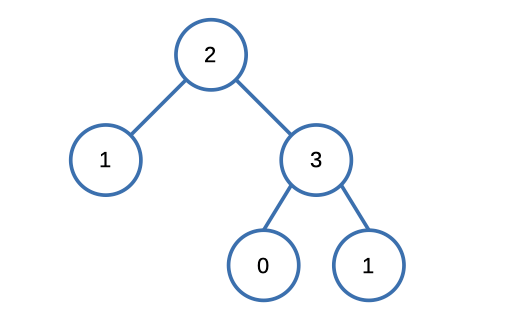LeetCode: 2331. Evaluate Boolean Binary Tree
The Problem
You are given the root of a full binary tree with the following properties:
- Leaf nodes have either the value
0or1, where0representsFalseand1representsTrue. - Non-leaf nodes have either the value
2or3, where2represents the booleanORand3represents the booleanAND.
The evaluation of a node is as follows:
- If the node is a leaf node, the evaluation is the value of the node, i.e.
TrueorFalse. - Otherwise, evaluate the node's two children and apply the boolean operation of its value with the children's evaluations.
Return the boolean result of evaluating the root node.
A full binary tree is a binary tree where each node has either 0 or 2 children.
A leaf node is a node that has zero children.
Example

Input: root = [2,1,3,null,null,0,1]
Output: true
Explanation: The above diagram illustrates the evaluation process.
The AND node evaluates to False AND True = False.
The OR node evaluates to True OR False = True.
The root node evaluates to True, so we return true.Constraints:
- The number of nodes in the tree is in the range
[1, 1000]. 0 <= Node.val <= 3- Every node has either
0or2children. - Leaf nodes have a value of
0or1. - Non-leaf nodes have a value of
2or3.
Solution
We opted for a recursive approach to tackle this problem, and upon evaluating our solution on the LeetCode platform, we achieved the following outcome:

Here's the code that led us to this result.
bool evaluateTree(TreeNode* root) {
if (root->val < 2) return (bool)root->val;
if(root->val == 3)
return evaluateTree(root->left) && evaluateTree(root->right);
return evaluateTree(root->left) || evaluateTree(root->right);
}🧠
Github with all the solution including test cases.
Let's break down the code:
if (root->val < 2) return (bool)root->val;: This is the base case of the recursion. It checks if the value of the current noderoot->valis less than 2. If it's less than 2 means it is a leaf, so we returs the boolean representation ofroot->val. In C++, casting an integer to a boolean will result intruefor non-zero values andfalsefor zero. So, it returnstrueifroot->valis 1 andfalseif it's 0.if (root->val == 3) return evaluateTree(root->left) && evaluateTree(root->right);: This part of the code is executed when the value of the current node is 3 meaning is andand operator. In this case, it recursively evaluates both the left and right subtrees using theevaluateTreefunction and returns the logical AND (&&) of the results. This means that for a node with a value of 3, both its left and right subtrees must evaluate totruefor the function to returntrue.return evaluateTree(root->left) || evaluateTree(root->right);: If none of the previous conditions are met, this part is executed. It recursively evaluates both the left and right subtrees using theevaluateTreefunction and returns the logical OR (||) of the results. This means that for a node with any value other than 0, 1, or 3, if at least one of its subtrees evaluates totrue, the function returnstrue.
